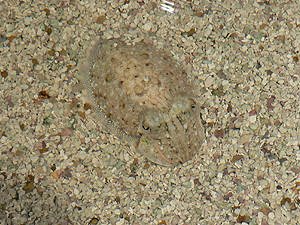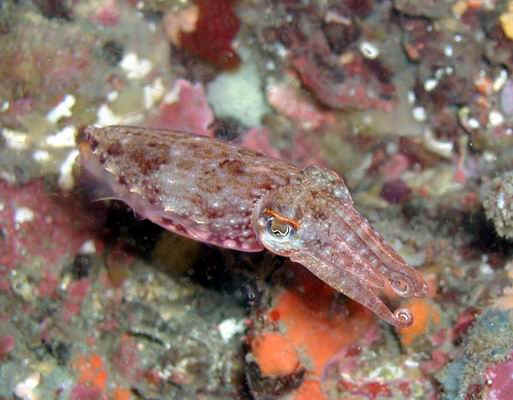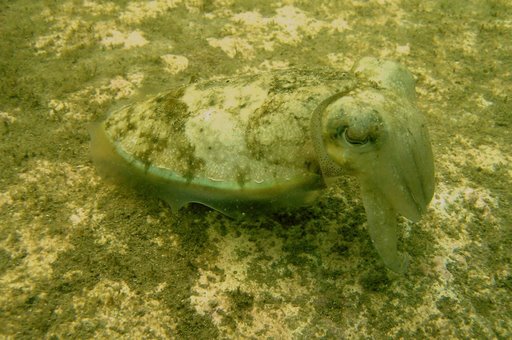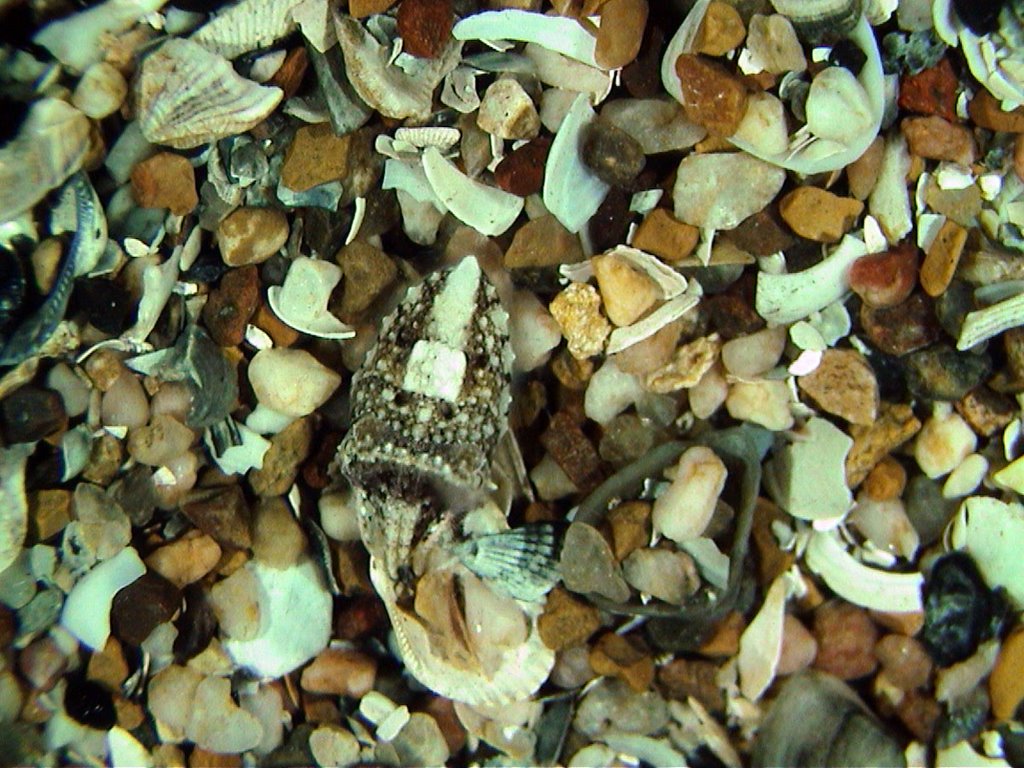



Cuttlefish are color blind and yet they are masters of camouflage. Scientists don't know how they read colors, which they can do in the dark, perhaps something about their skin. Although camouflage is a tactic to avoid being seen by predators, male cuttlefish will sometimes disguise themselves as a female to sneak into another male's harem and mate. (Scroll down for article)
 |
 |
|||
 |
 |
|||
:Revealed: Secrets of the Camouflage Masters.
The New York Times Feb 19, 2008
by Carl Zimmer
The cuttlefish in Roger Hanlon's laboratory were in fine form. Their skin was taking on new colors and patterns faster than the digital signs in Times Square.
Dr. Hanlon inspected the squidlike animals as he walked past their shallow tubs, stopping from time to time to ask, ''Whoa, did you see that?''
One cuttlefish added a pair of eye spots to its back, a strategy cuttlefish use to fool predators. The spots lingered a few seconds, then vanished.
When Dr. Hanlon stuck his finger into another tub, three squirrel-size cuttlefish turned to chocolate, and one streaked its back and arms with wavy white stripes.
''Look at the pattern on that guy,'' he said with a smile as they lunged for his finger.
In other tubs, the cuttlefish put on subtler but no less sophisticated displays. Dr. Hanlon's students had put sand in some tubs, and there the cuttlefish assumed a smooth beige. On top of gravel, their skins were busy fields of light and dark.
Dr. Hanlon likes to see how far he can push their powers of camouflage. He sometimes put black and white checkerboards in the tubs. The cuttlefish respond by forming astonishingly sharp-edged blocks of white.
''We can give them any hideous background,'' he said, ''and they will try to camouflage.''
Cuttlefish and their relatives octopus and squid are the world's camouflage champions. But Dr. Hanlon and his colleagues have just a rough understanding of how these animals, collectively known as cephalopods, disguise themselves so well.
Dr. Hanlon, a senior scientist at the Marine Biological Laboratory here, has spent much of the last three decades studying them in his laboratory and on thousands of ocean dives. He said he believed that he finally had a theory for how they achieve their magic.
In fact, he said it could account for all the camouflage patterns made by animals like katydids and pandas. For all the variety in the world of camouflage, there may be a limited number of ways to fool the eye.
Dr. Hanlon's scientific career was a foregone conclusion. At age 18, he took his first dive in Panama and spotted an octopus hiding on a coral reef. After serving as an Army lieutenant for two years, he entered graduate school at the University of Miami, where he began to study cephalopod camouflage.
He has spent much of his career underwater, swimming around coastal reefs and rocky coastal waters from the Caribbean to South Africa to Australia.
Typically, Dr. Hanlon and his colleagues follow a single cephalopod, filming for hours as it shifts its skin. On some dives, Dr. Hanlon uses a spectrometer to obtain precise measurements of the light in the water and the reflections from the animal. The tedium is interrupted now and then by acts of spectacular deception. Cephalopods do not just mimic the colors of the sea floor or coral reefs. Sometimes, they make their arms flat and crinkled and wave them like seaweed.
Dr. Hanlon has watched octopuses perform what he calls the Moving Rock Trick. They assume the shape of a rock and move in plain sight across the sea floor. But they move no faster than the ripples of light around them, so they never seem to move.
Dr. Hanlon's jaw-dropping footage has appeared on a number of documentaries. One pirated segment has wound up on YouTube, where it has been viewed hundreds of thousands of times.
Dr. Hanlon approaches normal-looking coral at Grand Cayman Island. When he is a few inches away, half the coral suddenly becomes smooth and white. An eye pops open, and an octopus that has been clinging to the coral shoots away.
Despite thousands of dives, Dr. Hanlon still considers himself a novice in spotting cephalopods. Once, after following an octopus for an hour and a half, he looked away a moment to switch cameras. When he looked back, the animal was gone.
He and his colleagues swam for 20 minutes before realizing it was right in front of them, exactly where they had seen it before. ''I was really angry,'' Dr. Hanlon said. ''They still fool me, even though I think I know what I'm looking at.''
In recent years, Dr. Hanlon has been spending much of his time diving along southern Australia, where a colleague discovered the only major spawning grounds for cuttlefish ever found. Every year, hundreds of thousands of Australian giant cuttlefish gather there to mate and lay eggs. ''I'd been searching for a place like that for 25 years,'' he said. ''The first time I stuck my head in the water, I said, 'I've died and gone to cuttlefish heaven.' ''
In his cuttlefish heaven, Dr. Hanlon has discovered new dimensions to camouflage. Curious to observe the animals at night, he and his colleagues used an underwater robot to film them in dim red light. The footage revealed something never seen before, cephalopods disguising themselves at night.
''This was stunning to us,'' Dr. Hanlon said. ''They were perfectly camouflaged no matter where they were.''
Evidently, they have to hide even in darkness from dolphins and other predators.
Cuttlefish can also use camouflage to deceive other cuttlefish, Dr. Hanlon and his colleagues have found. A male cuttlefish will typically guard several females from other challengers. He does not often have physical fights. It is enough for him to put on a powerful visual display.
But if another male disguises its skin to look female, he can sneak up to the guarded female and mate. The sneaky male's disguise may be so good that the other male may try to guard him as part of his harem.
Beyond documenting the varieties of camouflage, Dr. Hanlon also wants to understand how the animals produce them. At his lab, he studies the powerful visual system of cuttlefish. Cephalopods have huge eyes, and much of their brain is dedicated to processing visual information. They use this information to control their disguises through a dense network of nerves running from the brain to the skin.
The animals use a number of strategies to alter appearances. The skin layers can swell and contract, changing the reflected colors. At the same time, the cuttlefish can also control millions of pigment-filled organs, causing them to flatten like pancakes to add patterns to their skin.
''It's smart skin,'' Dr. Hanlon said. ''It's all wired up.''
Edwin Thomas, an engineer at the Massachusetts Institute of Technology, was so impressed by Dr. Hanlon's work on cuttlefish skin that he decided to mimic it. Dr. Thomas and his colleagues created a thin layer of gel that changes colors when it swells with water and shrinks. ''Roger's animals can also do that,'' Dr. Thomas said, ''but they're doing it without scientists involved.''
For all the complexity of their skin, Dr. Hanlon suspects that the cephalopods also use mental shortcuts. ''They don't have time to analyze all this visual information,'' he said.
A clue to how cephalopods disguise themselves so quickly came to Dr. Hanlon when he and his colleagues reviewed thousands of images of cuttlefish, trying to sort their patterns into categories. ''It finally dawned on me there aren't dozens of camouflage patterns,'' he said. ''I can squeeze them into three categories.''
One category is a uniform color. Cephalopods take on this camouflage to match a smooth-textured background. The second category consists of mottled patterns that help them hide in busier environments. Dr. Hanlon calls the third category disruptive patterning. A cuttlefish creates large blocks of light and dark on its skin. This camouflage disrupts the body outlines.
To test this hypothesis, Dr. Hanlon and his colleagues have been giving cuttlefish carefully controlled background patterns to match, natural patterns like sand and gravel as well as artificial ones like checkerboards. The researchers film the cuttlefish and classify them with image-processing software.
The three-category hypothesis has been holding up, Dr. Hanlon said. He illustrates it in spectacular fashion with a cuttlefish sitting on sand. If he drops a few white rocks into the water, the cuttlefish immediately inspects them and adds what looks like a white rock to its skin, disrupting its outline.
Innes Cuthill, an expert on camouflage at the University of Bristol, called Dr. Hanlon's research fascinating and inspiring. Dr. Cuthill agreed that cuttlefish had limits to its camouflage. ''It can't reproduce the Mona Lisa on its back,'' he said.
But he still considers it an open question how much the constraints come from cuttlefish brain wiring and how much from the limited range of backgrounds that cuttlefish encounter.
What he learned from cephalopods may apply throughout the animal kingdom. The fact that cephalopods may need just three camouflage categories could mean that there are just a few basic ways to fool predators.
Recently, Dr. Hanlon and students sorted through thousands of pictures of other camouflaged animals and found that they appeared to fall into the same three categories. A frog may have drab skin to blend into the drab forest floor. A bird may have mottled plumage, so that it matches the leaf and branch pattern surrounding it.
Dr. Hanlon argues that the black and white patches on a giant panda are a form of disruptive camouflage. If a panda is up in a tree, the chunks of black and white blend into the sunlight and shadows. It may be able to hide on a snowy landscape this way, as well.
Cephalopods are singular for changing quickly among all three categories. Chameleons can change between them, too, but they shift slowly, as hormones spread across their skin.
Dr. Hanlon is looking for more evidence for his three categories by figuring out the rules that cuttlefish use to decide how to hide themselves. Although he says he has found some rules, there is much to figure out.
To use disruptive patterning, cuttlefish need to make sure that their color blocks are on the same scale as the objects around them. Dr. Hanlon has yet to figure out how they measure that.
''They're doing it in some magical way we don't yet understand,'' he said.
Dr. Hanlon and his colleagues are also puzzled by the many camouflage colors of the cuttlefish, which have a single type of pigment in their eyes. Humans have three.
Experiments in Dr. Hanlon's lab have shown that they are color blind. They see a world without color, but their skin changes rapidly to any hue in the rainbow. How is that possible?
''That's a vexing question,'' he said. ''We don't know how it works.''